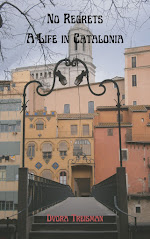As is sometimes the case when I travel, this year’s vacation
included a pilgrimage. Most years my vacation
base is Avignon. Avignon is a hub which
makes it convenient for visiting other towns in the area, it has some great
restaurants, it’s beautiful, provides for some great walks, and each time I go
there it becomes more like a second home, so going there is enjoyable and
comfortable. The fact that it was once
the papal seat means nothing to me except that it resulted in the monumental
Pope’s Palace.
Arles, however, was always special because Vincent van Gogh
lived there for 16 months and created 200 paintings and 100 drawings during that short time. Many of these paintings are among his most
famous. It was where Gauguin came to
live with him – a disaster of a visit that ended in Van Gogh’s mutilating his
ear and setting off the series of his worst epileptic fits – what became the
beginning of the end for him.
Clearly the bridge sits across a waterway, but the road
directions seemed to take you off onto some sort of highway that doesn’t run
along the river. Since I always go to
Arles by train, I wanted to walk to the bridge.
I knew it was no longer in its original location, but I didn’t want to
navigate along a highway full of traffic to get to it. So this time I wrote in advance to the Arles
tourist office to ask for directions to get there by foot.
I saved my visit to the fabulous Saturday market for after
my pilgrimage, passing through it quickly and then off onto the footpath that
followed a canal to my destination. The
nice man at the tourist office said would take 30-40 minutes to walk to.
It’s 2.7 kilometers from Arles to the bridge, and it took me
almost an hour. But never mind. It was a lovely walk along a canal and well
worth the time. Maybe it took me so long
because I was constantly stopping to take pictures: of the canal, of the boats and barges, of the
fishermen, and of the old Citroens.
Coming around a bend and seeing the bridge from a distance
was an “Oh my goodness” moment.
Inspecting it at close quarters was a real pleasure. No lines, no barriers, almost no people. There were two young
German families there too, so I just about had the place to myself.
The original bridge was built in the first half of the 19th
century as part of a project to expand the networks of canals that go to the
Mediterranean. That was replaced in 1930
by a reinforced concrete bridge that in 1944, along with all but one of the
other bridges along the canal, was blown up by the Germans. The only surviving bridge was moved in 1959
to the site along the canal, a little outside of Arles, where it now sits and
where people like me come to pay their respect.























I still want to see the bridge! I love Arles, have been twice and thoroughly enjoyed the town both times. The first time, in June, was during their annual festival, when the locals dress up in their traditional clothing, and there's events all over town. Food, music, dancing, bull-dancing in the arena. Wonderful. thanks D!
ReplyDeleteThanks, Jill!
Delete